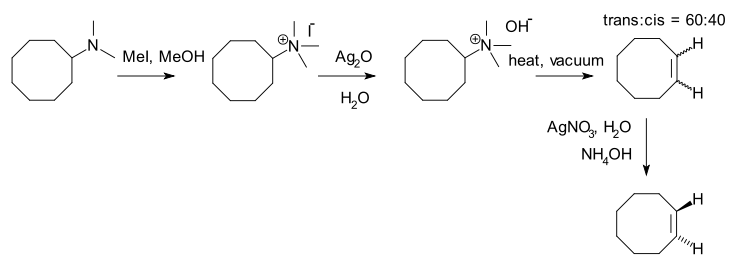Hofmann elimination
Hofmann elimination, also known as exhaustive methylation, is a process where a quaternary amine is reacted to create a Tertiary amine and an alkene by treatment with excess methyl iodide followed by treatment with silver oxide, water, and heat.
After the first step, a quaternary ammonium iodide salt is created. After replacement of iodine by an hydroxyl anion, an elimination reaction takes place to the alkene.
With asymmetrical amines, the major alkene product is the least substituted and generally the least stable, an observation known as the Hofmann rule. This is in direct contrast to normal elimination reactions where the more substituted, stable product is dominant (Zaitsev's rule).
The reaction is named after its discoverer, August Wilhelm von Hofmann.[1]
An example is the synthesis of trans-cyclooctene:[2]
In a related chemical test called Herzig–Meyer alkimide group determination a tertiary amine with at least one methyl group and lacking a beta-proton is allowed to react with hydrogen iodide to the quaternary ammonium salt which when heated degrades to iodomethane and the secondary amine.[3]
See also
References
- ↑ Aug. Wilh. von Hofmann (1851). "Beiträge zur Kenntniss der flüchtigen organischen Basen". Annalen der Chemie und Pharmacie. 78 (3): 253–286. doi:10.1002/jlac.18510780302.
- ↑ Arthur C. Cope; Robert D. Bach (1973). "trans-Cyclooctene". Org. Synth.; Coll. Vol., 5, p. 315
- ↑ J. Herzig; H. Meyer (1894). "Ueber den Nachweis und die Bestimmung des am Stickstoff gebundenen Alkyls". Berichte der deutschen chemischen Gesellschaft. 27 (1): 319–320. doi:10.1002/cber.18940270163.

